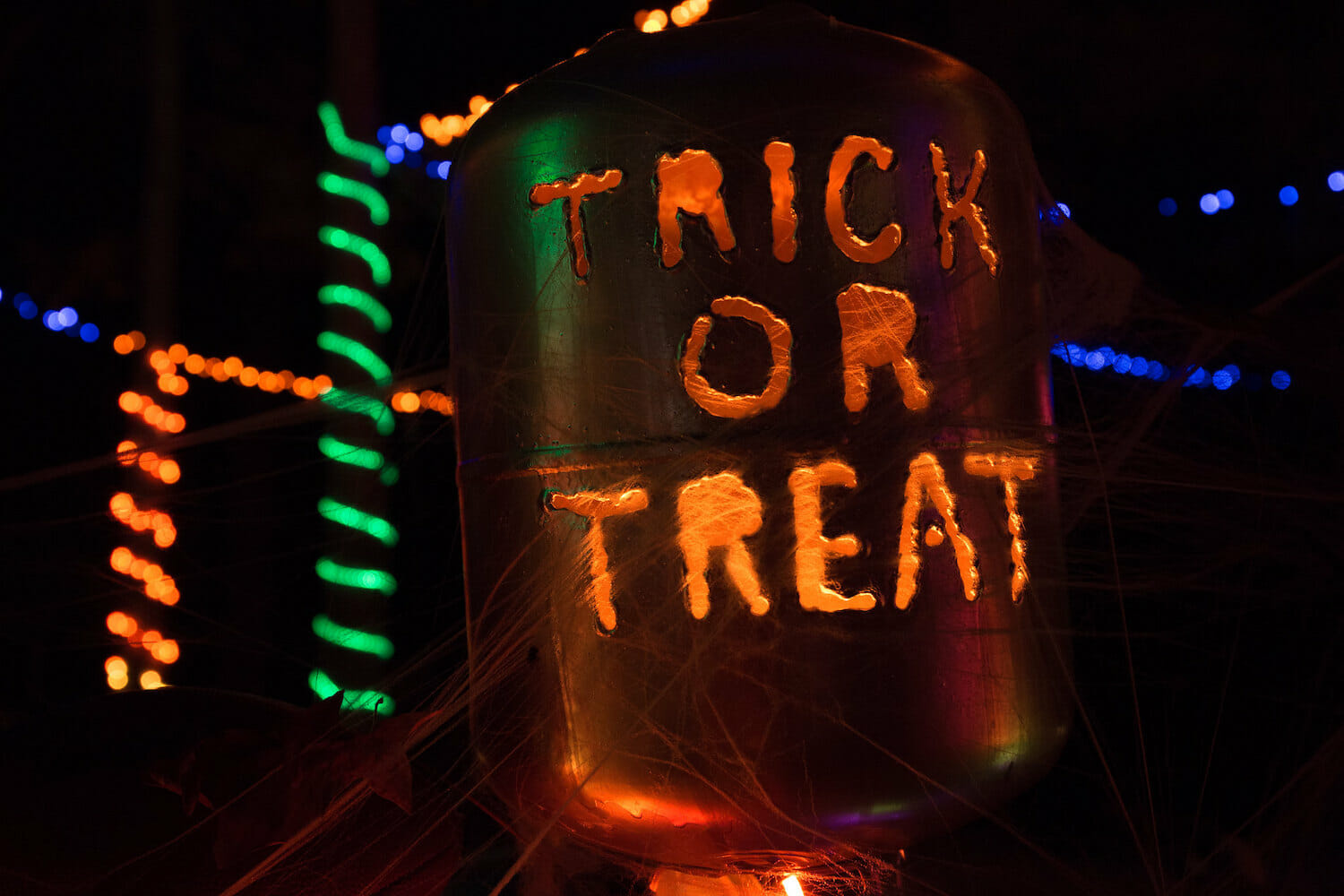As an independent news outlet, we enjoy the privilege of covering issues that bigger outlets won’t. At Los Angeleno, we write about people, places and idiosyncrasies with local impact and beyond. Your support is vital for us to continue doing so.
With your help, we can continue to write the first draft of history in Los Angeles. Check out our membership options and join today!
Trick-or-treating has become a very dramatic subject in Los Angeles this year. First, county health officials banned the Halloween tradition. Then the county Department of Public Health revised its guidelines, declaring that trick-or-treating was simply “not recommended.” Meanwhile, the state “strongly discourages” trick-or-treating but has yet to outlaw the practice, and recently, Beverly Hills resolutely declared, “not on my front porch.”
According to guidelines issued by the California Department of Public Health on Oct. 13, any holiday activities that “promote congregating and mixing of households” could increase the risk of passing the virus around.
“In general, the more people from different households with whom a person interacts, the closer the physical interaction is, and the longer the interaction lasts, the higher the risk that a person with COVID-19 infection — symptomatic or asymptomatic — may spread it to others,” the guidelines read. “Trick-or-treating without necessary modifications promotes congregating and mixing of many households, particularly on crowded doorsteps, which can increase the spread of COVID-19. That type of mixing is not currently permitted in California. Additionally, if there is a positive case discovered, it is very challenging to do appropriate contact tracing to identify all those who have been potentially exposed.”
The agency instead recommends marking the occasion with yard displays, online parties or contests, in-car events or at-home activities such as themed meals, scavenger hunts, scary movies and pumpkin carving. You can also turn your home into a haunted house. (Presumably by stopping by Spirit Halloween and buying some festive decor, not by opening a portal to a hell dimension in your living room, but the guidelines are pretty vague on that, so you do you.)
According to California Health and Human Services Secretary Dr. Mark Ghaly, these recommendations will not be enforced. “We don’t want to turn certainly what is a celebration and a time of joy into something that is difficult or contentious,” he told the L.A. Times, “but we also recognize the need to provide a clear understanding of the risks and why we recommend strongly that we do Halloween differently than we have in the past.”
Maybe it’s just too difficult to police what every single neighborhood in the state does, but it’s also been, well, pretty contentious already.
In the time it took for trick-or-treating to go from “not permitted” to “not recommended” in L.A. County, residents flocked to social media in defiance, threatening to hold Halloween protests.
During a subsequent press briefing, L.A. County Public Health Director Dr. Barbara Ferrer appealed to Angeleno’s logic. “There’s no guarantee when you go trick-or-treating that your child goes up to a house where the person who opens the door is wearing a face covering,” she said.
Meanwhile, the Beverly Hills City Council banned several Halloween traditions on Oct. 13, including trick-or-treating from house-to-house and car-to-car, giving treats or toys to anyone outside your household and spraying people with shaving cream. Exceptions apply for licensed barbers and people who are doing it in the privacy of their own homes. Violators are subject to citation. The city will also close several streets on Oct. 31 from 6-10 p.m. and implement parking restrictions where its northeast border meets West Hollywood.
“While I know this is disappointing news, especially to our children, we believe this is the responsible approach to protect the health of the community,” Beverly Hills Mayor Lester Friedman said in a written statement.
One has to wonder, is spraying people with shaving cream a typical Beverly Hills thing to do? Apparently, yes.
A 1994 Los Angeles Times article detailed all the Halloween mischief that occurred that year throughout the city:
“In Beverly Hills, hundreds of youths joined in what has become an annual egg-throwing and shaving cream-spraying melee in front of the multimillion-dollar mansions north of Santa Monica Boulevard,” it reads. “Besides some spray and eggs hitting property and some unlucky passersby, there was no damage reported. One juvenile was arrested for assaulting a police officer, however, when he smashed an egg on the officer’s chest.”
Spraying people and things with shaving cream is a pretty common Halloween prank, actually, perhaps much to the chagrin of adults and city officials.
In this 1984 segment, WABC reporter Will Spens talks to the NYPD about their attempts to save the city’s cemeteries from vandalism. “But what about this roving gang of Brooklyn shaving cream spreaders?” Spens asks of a group of middle-school-age boys covered in shaving cream. Shortly thereafter, a cop showed up to take their eggs and shaving cream away.
In 2009 in Quincy, Massachusetts, police started even earlier, asking convenience store owners to not sell eggs or shaving cream to minors on Halloween. Teens laughed at the idea of being carded for eggs because, as one of them pointed out, they could just stock up beforehand.
Why are pranks such a quintessential part of Halloween anyhow? Well, let us take you on a journey of Halloweens past!
The history of Halloween itself can be traced back to Samhain, a Celtic festival on Oct. 31 that marked the end of the harvest season. This was also said to be the time when the boundary between worlds is thinnest, meaning that supernatural beings could more easily cross into our realm. Lighting bonfires could ward them away, and dressing up as monsters or animals could protect you from harmful creatures, like a faerie that might try to kidnap you. Celebrants also carved faces into turnips, which look much creepier than pumpkins.
In the eighth century, the Catholic Church co-opted Samhain and established All Saints’ Day on Nov. 1. All Souls’ Day on Nov. 2 followed along in the ninth century. Oct. 31 became known as “All Hallows Eve” (“hallowed” meaning “holy”), and the Halloween we know and love is a blend of all of these traditions.
In medieval Europe, revelers would practice “mumming” and “guising,” which is when they would go around in costumes and sing in exchange for food. “Souling” was another tradition, this one tied to All Saints’ Day and All Souls’ Day, in which children and the poor would offer their prayers in exchange for “soul cakes.” These traditions came to the United States with Irish and Scottish immigrants.
In the U.S., people got pretty into Halloween pranking and vandalism, especially when the Great Depression hit in 1929. Some cities found pranks so annoying, or in some cases so dangerous, that they considered banning Halloween altogether. Over the years, kids would pull up crops, trip people with wires, let the livestock out of their pastures and light fires. Lisa Morton, author of “Trick or Treat: The History of Halloween,” told the Washington Post that communities ultimately developed “very institutionalized plans to control pranking by buying the kids off with parties.”
After WWII, trading tricks for sugary treats became a family-friendly autumn mainstay — though many communities still get in their fair share of mischief. Detroit, for example, changed its Devils Night on Oct. 30 to “Angels Night” after revelers set over 800 fires in 1984. That tradition was changed to “Halloween in the D” in 2018 after the city saw a significant decline in pre-Halloween arson.
And then there’s this year. Now instead of treats, you could just get COVID-19. For some L.A. County-approved, family-friendly Halloween alternatives, check out our list here.

